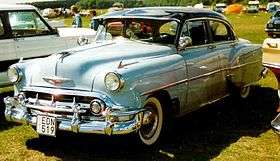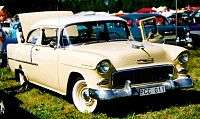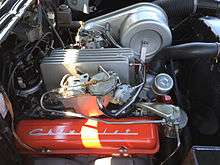Chevrolet 210
The Chevrolet Two-Ten, or 210, was the midrange model of the Chevrolet car from 1953 to 1957. It took its name by shortening the production series number (2100) by one digit in order to capitalize on the 1950s trend toward numerical auto names. The numerical designation '"210"' was also sporadically used in company literature. It replaced the Styleline DeLuxe model available in previous years. The Two-Ten was discontinued after the 1957 model year to be replaced by the Biscayne.
| Chevrolet 210 | |
|---|---|
 1956 Chevrolet Two-Ten 4-Door Sedan | |
| Overview | |
| Manufacturer | Chevrolet (General Motors) |
| Production | 1953–1957 |
| Assembly | Oakland Assembly, Oakland, California North Tarrytown Assembly, Tarrytown, New York Flint Assembly, Flint, Michigan Norwood Assembly, Norwood, Ohio St. Louis Assembly, St. Louis, Missouri Arlington Assembly, Arlington, Texas Oshawa Assembly, Oshawa, Ontario Canada |
| Body and chassis | |
| Layout | FR layout |
| Platform | A-body |
| Related | Chevrolet 150 |
| Chronology | |
| Predecessor | Chevrolet Deluxe |
| Successor | Chevrolet Biscayne |
History
The Two-Ten series, introduced for the 1953 model year, replaced the Styleline DeLuxe series. It was actually the best-selling Chevrolet model during 1953 and 54, offering a balance of style and luxury appointments unavailable in the base 150 series, but was less costly than the glitzy Bel Air. Two-Tens offered the widest choice of body styles for 1953, including a convertible, Sport Coupe hardtop, two- and four-door sedans, and four-door station wagons.
As the American public began to prefer posh to economy, the Bel Air began to outsell the lesser series, including both 150 and 210 models. As a partial answer to this, Chevrolet re-introduced the Two-Ten Sport Coupe hardtop in the middle of the 1955 model year, and also added a four-door Two-Ten hardtop Sport Sedan for 1956. Neither achieved the sales of their Bel Air counterparts, however, since they were only about $100.00 cheaper than the Bel Airs, which provided more luxury and premium exterior trim.
Unlike the 150 series, Two-Tens were always available with the same luxury options as the Bel Air, including the Powerglide automatic transmission, power window lifts and seat adjuster. The Two-Ten Townsman was the top station wagon model offered in 1953, but the Townsman was moved up to the Bel Air series for 1954, only to return to the Two-Ten for 1955. The lower-priced Handyman station wagon, a four-door model in 1953–54, became a two-door for 1955–57. Both were joined by a nine-passenger Beauville four-door wagon in 1956–57.
First generation (1953 to 1954)
| First generation | |
|---|---|
 1953 Chevrolet Two-Ten 4-Door Sedan | |
| Overview | |
| Production | 1953–1954 |
| Body and chassis | |
| Body style | 4-door sedan 2-door coupe 2-door hardtop 4-door wagon 2-door convertible |
| Powertrain | |
| Engine | 235 cu in (3.9 L) I6 |
| Transmission | 3-speed manual[1] 2-speed automatic |
| Dimensions | |
| Wheelbase | 115 in (2,921 mm) |
| Length | 195.5 in (4,966 mm) [1] |
| Width | 75 in (1,905 mm) |
1953–1954 models
First years for the Two-Ten. These model years are essentially the same except for minor front and rear trim items, and of course the reduced model offering in 1954. Turn signal indicators on 1953 dashboards were white, green in 1954.
Powertrains
Two engines were used in each of the '53-'54 model years, the more powerful Blue Flame unit used with the Powerglide automatic transmission. All Two-Tens had a three-speed Synchromesh manual transmission as standard, with two optional transmissions (see below). All engines are of the overhead valve (OHV) design. They are commonly referred to as "Stovebolt Sixes" because of the large slotted-head screws used to fasten the valve cover and pushrod covers to the block. 1954 was the last year for 6 volt electrical systems in Chevrolet vehicles.
- 235 in3 "Thrift-King" I6 rated at 108 hp (81 kW) (1953 manual transmissions)
- 235 in3 "Blue Flame" I6 rated at 115 hp (86 kW) (1953 Powerglide)
- 235 in3 "Blue Flame" I6 rated at 115 hp (86 kW) (1954 manual transmissions)
- 235 in3 "Blue Flame" I6 rated at 125 hp (93 kW) (1954 Powerglide)
Transmissions
- 3-speed Synchromesh manual
- 3-speed Synchromesh manual with overdrive unit
- 2-speed Powerglide automatic.
 1954 Chevrolet Two-Ten 4-Door Sedan
1954 Chevrolet Two-Ten 4-Door Sedan
Second generation (1955 to 1957)
| Second generation | |
|---|---|
1956 Chevrolet Two-Ten 2-Door Sedan | |
| Overview | |
| Production | 1955–1957 |
| Body and chassis | |
| Body style | 4-door sedan 2-door coupe 2-door hardtop 4-door hardtop (1956–57) 2-door wagon 4-door wagon |
| Powertrain | |
| Engine | 235 cu in (3.9 L) I6 265 cu in (4.3 L) V8 283 cu in (4.6 L) V8 |
| Transmission | 3-speed manual 2-speed automatic |
1955
The '55 model year marks the introduction of a new chassis and the debut of the small block V8. The center door frame was beefed up for more safety.[2] Brakes were 11-inch (280 mm) drums.[2] The Two-Ten buyer was free to choose any powertrain option available. The ammeter and oil pressure gauges were changed to warning lights.
This was not the first Chevrolet to have a V8 engine installed. The first Chevrolet with a V8 engine was introduced in 1917 called the Series D which was built for two years, and was manufactured before Chevrolet joined General Motors.
Engines
Transmissions
- 3-speed Synchromesh manual
- 3-speed Synchromesh manual with overdrive unit
- 2-speed Powerglide automatic.
 1955 Chevrolet 210 2-Door Sedan
1955 Chevrolet 210 2-Door Sedan 1955 Chevrolet Two-Ten 4-Door Sedan, turquoise with white top
1955 Chevrolet Two-Ten 4-Door Sedan, turquoise with white top.jpg) 1955 Chevrolet 210 2-Door Station Wagon
1955 Chevrolet 210 2-Door Station Wagon
1956
Engine choices remain the same except they were now rated with higher power output. The 265 cu in (4.3 L) V8 was available in three versions. The I6 had a new unified build no matter the transmission.
Engines
Transmissions
- 3-speed Synchromesh manual
- 3-speed Synchromesh manual with overdrive unit
- 2-speed Powerglide automatic
.jpg) 1956 Chevrolet Two-Ten 2-Door Sedan
1956 Chevrolet Two-Ten 2-Door Sedan.jpg) 1956 Chevrolet Two-Ten 4-Door Sedan
1956 Chevrolet Two-Ten 4-Door Sedan 1956 Chevrolet Two-Ten Sport Coupe
1956 Chevrolet Two-Ten Sport Coupe 1956 Chevrolet Two-Ten Station Wagon
1956 Chevrolet Two-Ten Station Wagon
1957
New for 1957 was the optional 283 cu in (4.6 L) small-block V8 engine. There were three versions of this engine with conventional carburetors, as well as a fuel injected option.
The Two-Ten shared the wedge-shaped side trim with the Bel Air, but unlike the Bel Air (which had the wedge filled with an aluminum trim panel) the Two-Ten's wedge was painted either body color, or top color with the optional two-tone paint package. "Chevrolet" in script was mounted inside the wedge.
Engines
- 235 in3 "Blue Flame" I6 rated at 140 hp (104 kW).
- 265 in3 "Turbo-Fire" OHV V8 rated at 162 hp (121 kW).
- 283 in3 "Super Turbo-Fire" OHV V8 rated at 185 hp (138 kW).
- 283 in3 "Super Turbo-Fire" OHV V8 with 4 barrel carburetor rated at 220 hp (164 kW)
- 283 in3 "Super Turbo-Fire" OHV V8 with dual 4 barrel carburetors rated at 270 hp (201 kW)
- 283 in3 "Super Turbo-Fire" OHV V8 with Rochester Ram-Jet fuel injection rated at 283 hp (211 kW)
Transmissions
- 3-speed Synchromesh manual
- 3-speed Synchromesh manual with overdrive unit
- 2-speed Powerglide automatic
- Turboglide variable-speed automatic
 1957 Chevrolet Two-Ten 2-Door Sedan
1957 Chevrolet Two-Ten 2-Door Sedan Fuel injected engine in 1957 Chevrolet Two-Ten 2-Door Sedan
Fuel injected engine in 1957 Chevrolet Two-Ten 2-Door Sedan.jpg) 1957 Chevrolet Two-Ten 4-Door Sedan
1957 Chevrolet Two-Ten 4-Door Sedan
Today
Today, the Bel Air series of Chevrolets from 1953 to 1957 are far and away the most desirable models for collectors. However, Two-Ten models do have appeal, especially the 1953 convertible (very rare), the Del Ray Club Coupe with its upgraded vinyl interior, and the Sport Coupe hardtops of 1953 and 1955-57. Other models are less valuable, but again, can be purchased for less money than Bel Airs, for Chevy collectors on a budget. Unlike the One-Fifty series, Two-Tens do sport a fair amount of chrome trim and de luxe interior appointments, making them attractive and comfortable.
References
- Flory, J. "Kelly", Jr. (2008). American Cars, 1946–1959: Every Model Every Year. McFarland & Company. ISBN 978-0-7864-3229-5.
- "Directory Index: Chevrolet/1955_Chevrolet/1955_Chevrolet_Prestige_Brochure". Oldcarbrochures.com. Retrieved 2012-05-31.